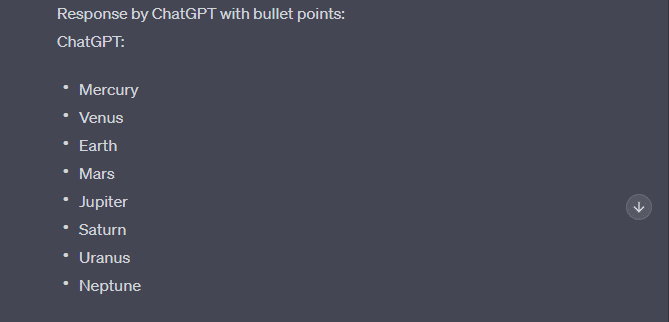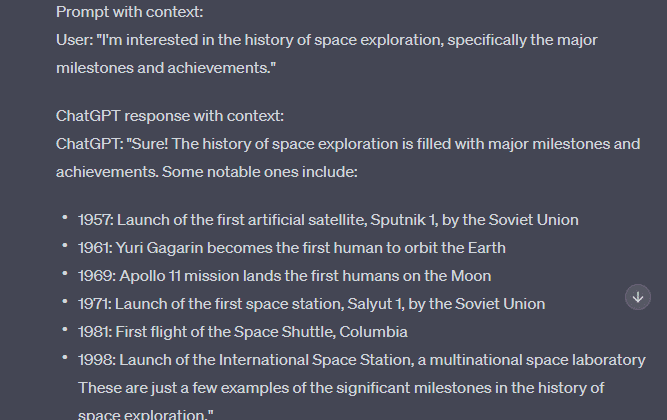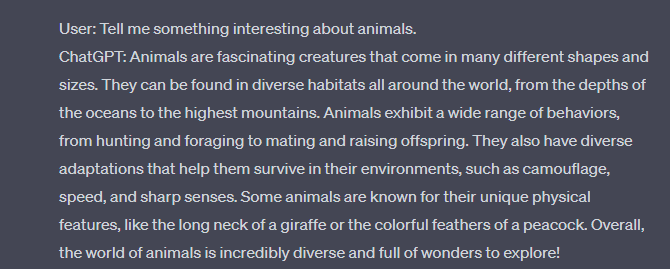Do you need help with generating long responses from ChatGPT or want to know how you can get long answers instead of incomplete responses, whether you’re generating an essay, source code, etc.? Or are you wondering why ChatGPT fails to produce such long answers?
ChatGPT is a revolutionary AI language model that has overtaken the world. Open AI’s latest language model can generate human-like text responses based on the input it receives from users. In addition, ChatGPT has been trained on vast data, making it understand and generate responses on various topics.
The AI model is valuable for content creation, brainstorming, and research assistance. But sometimes, ChatGPT fails to provide long answers to user queries.
This can be quite frustrating for users. If you are experiencing this, don’t worry. You are not alone. Numerous users have reported the same issue. In this guide, we look at 7 ways to obtain long and detailed responses from ChatGPT.
So without further ado, let’s get started.
Does ChatGPT Have a Word Count Limit on the Generated Responses?
From numerous tests, it can be seen that ChatGPT responses range around 500 words. This can be due to the high demand for the service or AI model, that responses need to be optimized and limited in order to provide concise but effective responses, so as not to require excessive tokens or hardware or computational power to generate repsonses.
However, if one feels that the response generated is incomplete or is cut off mid-sentence, they can request it to “continue”, and the AI will proceed from where it left off or will indicate otherwise. (Fix 3)
7 Ways to Get Longer Answers and Avoid Incomplete Responses on ChatGPT
1. Provide Clear and Concise Input
The first and foremost solution to this issue is providing clear input. You have to be specific in your prompts and provide context. The ideal technique is to break your query into bitesize manageable chunks. This enables ChatGPT to process information without the AI system becoming overloaded.
For instance, instead of writing long prompts with complex sentences, use concise and straightforward wording to enable ChatGPT to understand queries. If you follow this technique, you can generate long, accurate, and coherent responses from ChatGPT. Alternatively, you can use contractions or abbreviations to minimize the space occupied by your query while preserving its core message.
Additionally, you can remove redundant phrases from your input while providing only the necessary information so ChatGPT can respond accurately.
To comprehend this better, let’s look at an example of using a long and short prompt.

The prompt above is an example of a bad prompt. The user writes out a wordy and unnecessarily long query which will consume significant computing power and might lead to overload. On top of that, the user has not provided the context, and the request is vague. Instead of using the prompt above, you should use a prompt like this:

This prompt is straightforward and concise. It conveys the query straightforwardly and concisely, allowing ChatGPT to generate an effective and more efficient response.
2. Request ChatGPT to “Continue” Generating the Response
One simple solution if you find that ChatGPT produces incomplete responses or answers to your prompts or questions, is to prompt it to “continue”. So, you’re essentially requesting it to resume generating, elaborating or continuing from where it left off, simply by entering “continue”, “go on”, “is there anything else you wish to add on?”, or anything similar.

3. Regenerate the Response
Another possible workaround that is available for users is the Regenerate response button, which users can click to request ChatGPT to create a new but similar answer as the previous. Thus, you can try using this option and observe whether the same incomplete response issue is still prevalent in the new ChatGPT response. This workaround is more suitable if you were unsatisfied with the previous response from ChatGPT and would like a different answer to your prompt.

4. Adjust the Temperature and Max Length
Temperature and max length are crucial parameters affecting the quality and length of responses generated by ChatGPT. Temperature determines the randomness of the generated text, with higher values resulting in more randomness and creativity, while lower values make the output more focused and deterministic.
Max length, on the other hand, sets the limit for the length of the response. By adjusting these parameters, you can influence the length and quality of the answers from ChatGPT. You can experiment with different values to find the perfect balance that suits your needs.
Increasing the temperature or max length can result in long answers from ChatGPT. You can modify ChatGPT’s responses’ length and quality by adjusting the temperature and max length parameters.
In short, you can iterate and fine-tune these parameters to your liking to obtain the desired length and quality of responses. This doesn’t apply if you’re using ChatGPT through the chat.openai.com website, however for users developing using OpenAI’s GPT API.
5. Use Bullet Points
Employing bullet points or numbered lists is a very effective way of communicating with ChatGPT. It helps the AI model to understand your query with clarity. When you break down the long text in your prompt into small, digestible steps or sets of instructions, it becomes easier for ChatGPT to respond and understand the query. This eventually leads to ChatGPT generating sufficiently long responses that suit your needs.
For instance, if you are instructing the model on how to use a mobile application, then instead of writing a long instruction paragraph, you can simply break it down into a numbered list. Each bullet point or numbered item could represent a specific action or task that needs to be completed to use the program effectively.
Let’s look at how employing bullet points or numbered lists help generate long responses from ChatGPT.

Here the user needs to correct the mistake of not using bullet points or instructing ChatGPT to use bullet points; this makes the data appear messy and cluttered. As a result, the response needs to be longer and more irrelevant. But if the user instructs ChatGPT on using bullet points, it generates a longer response where the data is well organized and much more presentable:

Using bulleted or numbered lists in your prompt can make it easier for ChatGPT to understand the flow of conversation and provide long, clear, and organized responses.
6. Include Context in Your Prompts
Providing context in your queries or prompts can prove to be a total game-changer for ChatGPT. Providing context enables ChatGPT to understand the flow of your conversation better and to generate responses that are tailored to your needs and specifications. ChatGPT generates a more detailed and lengthy response by incorporating the specific topic of interest.
Context assists ChatGPT in comprehending the user’s inquiry and generates a more relevant and in-depth response. When the context is given, ChatGPT may use it to deliver a more in-depth response, including pertinent specifics and expanding on the subject. Let’s look at an example of how providing context vs. not providing affect the length and quality of responses generated.
Bad Prompt:

In this example, the user doesn’t provide any context to ChatGPT and simply asks vague questions regarding space exploration. This results in ChatGPT replying with a similarly vague answer of a few sentences that don’t fulfill the user’s requirements. Now let’s look at how providing context helps ChatGPT to understand the requirements of the user and to generate long responses:
Good Prompt:

Here the user provides adequate background information and context regarding what specifically he is looking for. He instructs ChatGPT to include major milestones and achievements. Now ChatGPT generates a much longer response which provides the notable achievements of space exploration in bullet form, which are much more relevant.
7. Use Sequential Prompts
Employing techniques like sequential messaging or prompts can generate accurate and longer responses from ChatGPT. For example, when addressing a series of queries or an abundance of detailed data, using sequential messaging in ChatGPT might be handy. This helps you to set the context and progressively advance the dialogue. For instance, you may ensure a compelling and thorough discussion by asking the following question or observing after ChatGPT addresses your initial contribution.
With ChatGPT, sequential messaging divides an increased volume of material into smaller, more targeted engagements. This is very helpful if you need to explain several different topics. With ChatGPT, you may create a more thorough and cohesive conversation by using sequential messaging. Additionally, by doing this, you can provide context, which can aid ChatGPT in better understanding what you are saying and responding more appropriately.
Let’s look at an example where not employing sequential prompts lead to an irrelevant response from ChatGPT.
Irrelevant Response:

Here the user asks a vague and generic question that doesn’t include any context or details regarding his query. As a result, ChatGPT returns an equally vague response that generally tells the user about animals. Let’s look at an example where the user gradually uses sequential prompts to build the context and obtain relevant information.
Relevant Response using Sequential Prompts:

Here the user starts with a generic question to help ChatGPT understand the context of his query. He says he is looking to travel to Japan and then asks for recommendations for famous places. Then he employs further sequential messaging to narrow down his activities to outdoor. This leads to ChatGPT providing highly relevant responses custom-tailored to the user’s needs.
Conclusion
In conclusion, ChatGPT is an excellent AI model, but sometimes it can malfunction and prevent users from getting long responses. Obtaining long answers and responses from ChatGPT requires providing clear and detailed input, using prompts with multiple parts, requesting step-by-step thinking, specifying the response format, and adjusting the temperature and max length parameters. Fortunately, several techniques allow users to send long input to ChatGPT.
Implementing the techniques in our guide allows you to obtain lengthy inputs to ChatGPT more effectively. This will result in more meaningful and concise interactions with the AI. We hope this guide solved your issue with obtaining long responses to ChatGPT.
Lastly, don’t forget to share this guide with peers who experience difficulty with ChatGPT.
